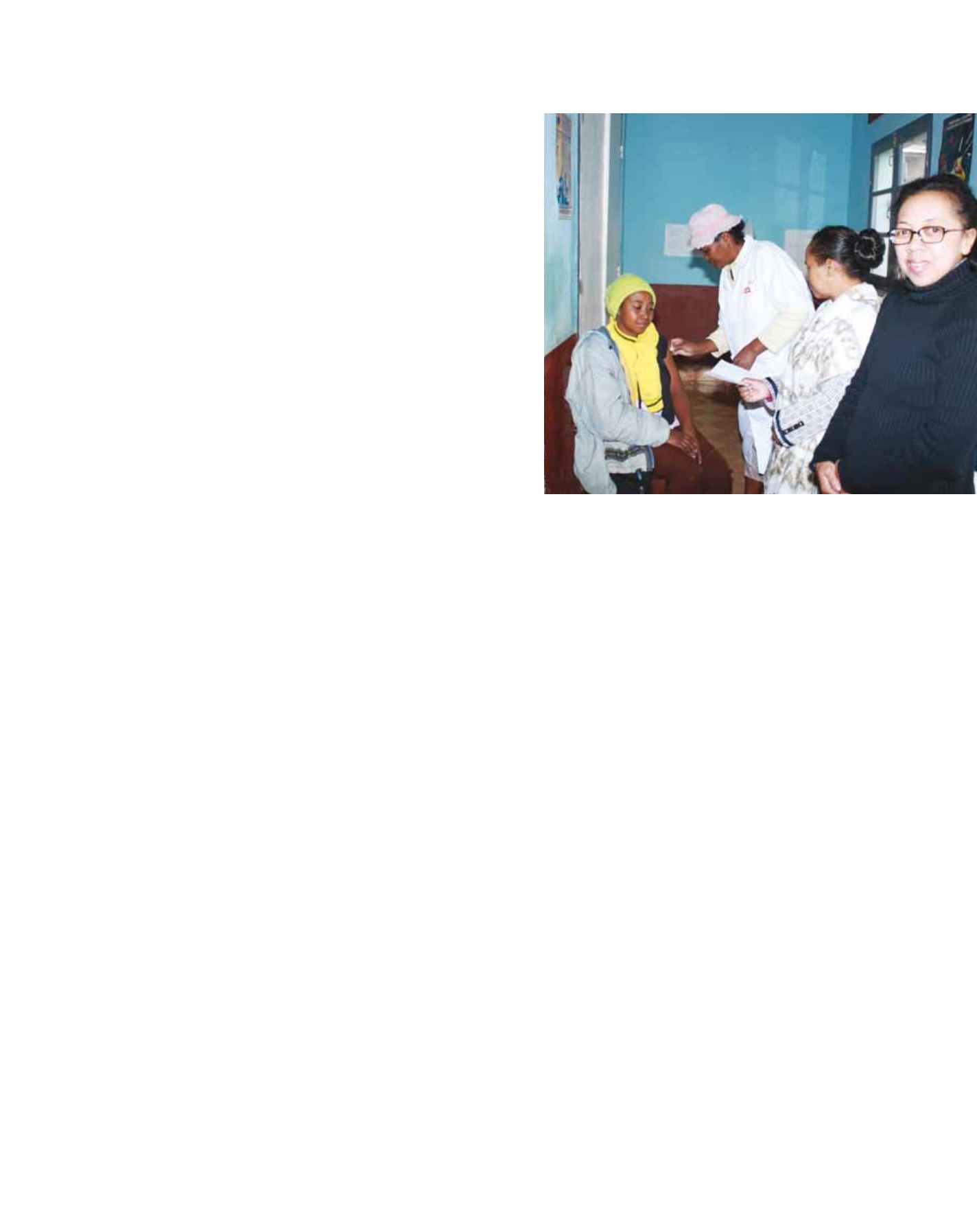

[
] 117
H
ealth
Rift Valley fever
Rift Valley fever is a viral anthropozoonosis transmit-
ted by mosquitoes. Not much is known about the
virus reservoir and the impact on it of climate or envi-
ronmental changes. The presence of the RVF virus in
Madagascar was demonstrated in 1979 by isolations
from mosquitoes captured in the Moramanga district
rain forest 130 km east of Antananarivo. Since then,
epidemics of RFV have been linked to climate changes
and ecological perturbations caused by humans, favour-
ing the population dynamic of the mosquito vectors and
the transmission of the virus. Its impact is socially and
economically important because it affects both cattle
and human populations.
A workshop to launch the pilot project in October
2008 resulted in the signature of a memorandum of
understanding (MOU) for partnership in climate and
health by ministers and the appointment of two project
coordinators: one specialist and an expert in climate. It
also led to the establishment of the Madagascar Climate
and Health Working Group (CHWG) and the definition
of the terms of reference and formal appointment of the
members (Ministry of Health, Ministry in Charge of the
NMHS, Institut Pasteur de Madagascar, World Health
Organization, Roll Back Malaria, USAID, and Institut
National de Santé Publique et Communautaire).
The CHWG aims to identify the information and
service needs of the health sector, including gaps in
current data, information and service delivery, and
to provide recommendations for filling these gaps.
Strategies include institutional data sharing and target-
ing of research, education and training needs across
the sectors. Access to climate and weather tools for
in 2003 when the malaria unit of the Ministry of Health met
NMHS representatives following an outbreak. The aim was to
establish a close collaboration between the unit and the Applied
Research Service of the NMHS for malaria monitoring, prevention
and response. This collaboration was strengthened by partici-
pation of malaria unit staff in the United States International
Research Institute for Climate and Society (IRI) summer institute
and of Applied Research Service staff in the Southern African
Development Community (SADC) Climate Expert Meeting and
the Southern African Regional Outlook Forum (SARCOF) in
2005. The Epidemiological Surveillance Service, the Institut
Pasteur de Madagascar and international organizations working
in the health sector such as UNICEF and the President’s Malaria
Initiative/United States Agency for International Development
were also included.
This existing cooperation was one of the criteria used by the World
Meteorological Organization (WMO) in the selection of Madagascar as
the first country for the implementation in 2008 of a Learning Through
Doing pilot project focusing on the use of climate information in
support of the health sector. The project objectives were:
• To help Madagascar’s National Weather Service to meet the
specific needs of the health sector in terms of climate data and
information
• To adopt new working methods in the health sector with regard
to the effective and efficient use of climate data and information
for the prevention of epidemics.
The key outcomes expected from the project were:
• Improved service delivery
• Enhanced capacity in the NMHS
• Better use of weather and climate services in the health sector.
Within the framework of the project, three diseases were considered:
malaria, plague and Rift Valley fever (RVF). However, the outcomes
could be extended to all climate-sensitive diseases.
Malaria
Malaria remains the primary public health problem in Madagascar.
In sub-arid regions like the southern part of the country, malaria is
influenced by climate, as rainfall is very important to development
of mosquito breeding sites. Malaria prevails mainly during the wet
season in all districts of the island. The Central Highlands area has
a marked seasonality with an almost total absence of malaria during
the winter period. Fever surveillance has taken place since 2007 in
thirteen sites across Madagascar and climate variability information
will be helpful for understanding the distribution of malaria cases.
Plague
From 1957 to 2001, 20,900 suspected cases of plague were notified
in Madagascar, including 4,473 confirmed or probable bacterio-
logical (21.4 per cent). There have been two important increases
in plague incidence: between 1985 and 1990, partly due to the
socioeconomic difficulties of the country, and from 1994 to 1997,
following improvements to the epidemiological monitoring system
and the reappearance of the plague in the port of Mahajanga.
Endemic plague is prevalent from September to March (hot and wet
season) and July to November (dry season) respectively in the high-
lands and Mahajanga. This confirms the importance of the climate
component in plague surveillance.
From right, the project coordinator and co-chair of the CHWG, the
focal point for the Rift Valley Fever, with staff and patient
Image: Madagascar Met Services
















